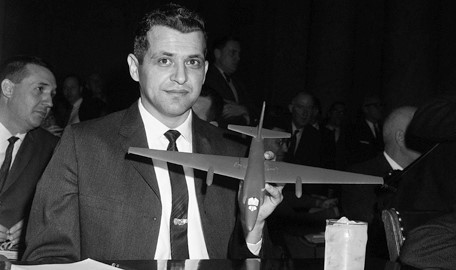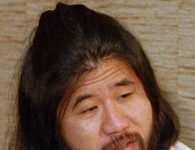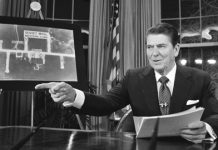On February 10, 1962, U-2 spy plane pilot Francis Gary Powers was returned to the United States in a prisoner exchange. Powers had been shot down in May 1960, creating an incident that destabilized American-Soviet relations.
Powers Returns to United States
Francis Gary Powers, the pilot of a CIA U-2 spy plane, was shot down by a Soviet missile on May 1, 1960. Powers parachuted to safety, but he was unable to activate a mechanism in the plane that destroyed its camera and film. Choosing not take an optional poison pill that was supplied to him, he was soon captured by Soviet authorities.
The incident caused great embarrassment for President Dwight Eisenhower and his administration. East-West relations reached new levels of hostility, as Soviet head Nikita Khrushchev walked out on the Paris Summit peace conference later that May.
Powers pleaded guilty to espionage that August and was sentenced to 10 years in a Soviet prison. He served 21 months before the United States secured his release through a prisoner exchange deal. He and Frederic Pryor, an American student who had been arrested in East Berlin, were exchanged for Rudolf Abel, a Soviet spy who had been arrested in 1957.
Powers received an unfriendly welcome when he returned home. Many Americans criticized him for failing destroy the evidence of his spying and for falling into enemy hands rather than committing suicide. However, the CIA and Senate Armed Services Select Committee investigated the matter and each determined that Powers had acted appropriately.
Background: The U-2 Incident
The U.S. military had developed the U-2 spy plane in the 1950s in response to concerns about the Soviet Union’s growing array of military technology. The plane could fly at 70,000 feet, a height the United States believed was out of range for Soviet radar.
The CIA began operating U-2 spy missions in July 1956, and continued them over the next four years. Unbeknownst to the CIA, the Soviets did detect the plane on their radar, but they lacked the weaponry to shoot down the aircraft.
A U-2 plane did go down over Soviet territory in 1959, “but as long as there was no definitive proof connecting the flights to the United States there was no advantage for the Soviets to raise the issue publicly lest it draw attention to the Soviet inability to shoot down the offending flights,” according to the U.S. State Department.
The U-2 intelligence showed that the United States’ concerns over Soviet military technology were unfounded. However, the CIA continued to operate missions. A U-2 flight on April 9, 1960, was attacked by Soviet fighter jets, which were unable to hit the aircraft.
On May 1, the CIA sent out the U-2 plane flown by Powers. Eisenhower, who personally approved each U-2 mission, authorized the flight “against his better judgment,” according to newsman Walter Cronkite.
Powers, flying 2,900 miles from an American base in Pakistan to a base in Norway, was detected almost immediately after he entered Soviet territory, and attacked by MiG-19 and Su-9 jets and SAM ground missiles. Sergei Khrushchev, Nikita’s son, reports that several attacks—including a Kamikaze-style attack—failed before a SAM missile exploded behind the U-2 plane, disabling it.
Powers was unable to use his ejection seat, writes his son, Francis Gary Powers, Jr. in American Heritage. Instead, he opened the top on the plane and attempted to crawl out; when he removed his seat belt, he was immediately flung from the plane before he could activate the plane’s destruct mechanism. He was arrested soon after he landed on the ground.
Sources in this Story
- Smithsonian Magazine: Gary Powers Kept a Secret Diary With Him After He Was Captured by the Soviets
- Time: Abel for Powers
- The Cold War Museum: The U-2 Incident
- U.S. Department of State: Office of the Historian: U-2 Overflights and the Capture of Francis Gary Powers, 1960
- Yale Law School: The Avalon Project: The U-2 Incident of 1960
- NPR: Loss of Spy Plane Sabotaged 1960 Summit
- American Heritage: The Day We Shot Down The U-2
- American Heritage: A Few Words in Defense of Francis Gary Powers
- Check-Six.com: The Francis Gary Powers Helo Crash
The incident occurred just 15 days before Eisenhower and Khrushchev planned to meet at an East-West summit in Paris with the heads of France and Great Britain.
Hoping to conceal the existence of the U-2 missions, the Eisenhower administration prepared a cover story. NASA put out a press release announcing that a weather research plane flying over Turkey had gone off track and possibly crashed in Soviet territory.
On May 5, Khrushchev declared that the Soviets had shot down a U.S. spy plane, but did not disclose the fact that Powers had survived. The State Department, believing that Powers was dead and was thus unavailable to confirm the true nature of the mission, issued a statement corroborating the NASA statement.
On May 7, Khrushchev announced that Powers was alive and that the Soviets had evidence he was operating a spy plane. “Like a chess master, the Soviet leader had lured his opponent into position and then sprung his trap,” recalled Cronkite. “With Powers alive in Moscow, Khrushchev had caught the United States in an untenable lie to its own people and the world.”
The State Department conceded on May 9 that it had operated spy missions over Soviet airspace. Two days later, Eisenhower admitted that he knew of the spying, but he was unapologetic in saying that such missions were necessary for the country’s safety.
“Eisenhower’s statement left Khrushchev in a difficult position,” explains the State Department. “If he did nothing, that would be tantamount to acknowledging implicitly the right of the United States to spy. But any action Khrushchev did take had the potential to scuttle the upcoming conference and his larger plans for a Soviet-American detente.”
Khrushchev demanded an apology and an end to American spying; Eisenhower refused to grant either. When they gathered in Paris, the two refused to shake hands or greet each other. Khrushchev led the Soviet delegation in walking out of the summit soon after it began.
Related Events
Key Player: Francis Gary Powers
Powers was an unpopular figure in the years following the U-2 incident. Though the CIA determined that he had behaved admirably and awarded him the Intelligence Star (the second highest honor bestowed by the agency), its findings were kept confidential.
He went on to work for Lockheed as a test pilot and later for two California news stations as a helicopter traffic reporter. He died on August 1, 1977, when his helicopter ran out of fuel and crashed.
On May 1, 2000, 40 years after he was shot down, Powers was posthumously awarded the Distinguished Flying Cross, Department of Defense Prisoner of War Medal and National Defense Service Medal.
Reference: Powers and U-2
The CIA has made public 70 documents on Powers’ Soviet trial, his release, the CIA investigation and honors awarded to him.
The Eisenhower Library has a collection of memorandums, press releases and internal reports on the U-2 incident in PDF form. Yale Law School’s Avalon Project has several of the documents in HTML.
The CIA’s Center for the Study of Intelligence released a history of the U-2 missions in 1998, “The CIA and the U-2 Program.” It is available in a PDF document.











